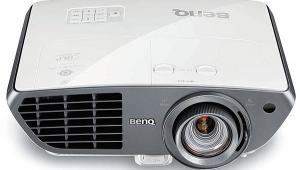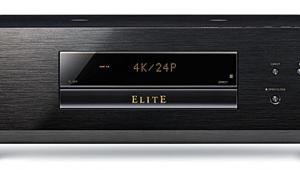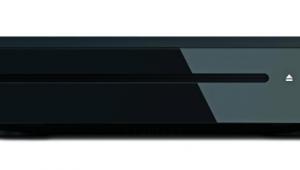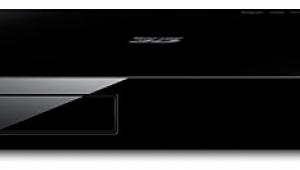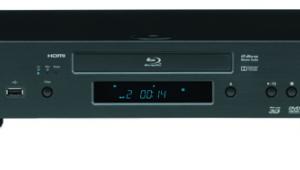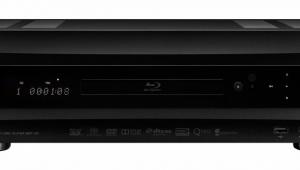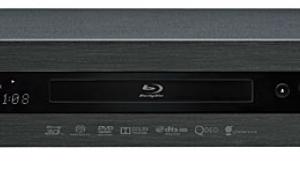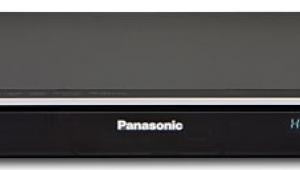LG BP620 Blu-ray 3D Player

The SEC (Securities and Exchange Commission) requires mutual fund companies to tell investors that a fund’s past performance does not necessarily predict future results—and the same could be said of Blu-ray players. In the case of LG, I’ve had the opportunity to audition its top-of-the-line offering for each of the past four years. In 2009, the company’s BD390 (Home Theater, January 2010) was the fastest player I’d ever used, and in July 2010, I awarded its BD590 a Top Pick because of its solid Blu-ray performance and plethora of streaming services. Unfortunately, in 2011 LG dropped the ball with the BD690 (Home Theater, September 2011) with faulty firmware releases and buggy disc playback.
What about 2012? Enter the BP620 with many of the amenities from last year’s flagship model—sans the built-in hard drive for ripping CDs directly into the unit—at a budget-friendly price of only $150. Can the company regain its footing and deliver a solid player at a reasonable price?
Economy Class
Weighing in at only 4 pounds, the BP620 won’t be contending in the heavyweight division of Blu-ray players. But in our digital world, the size and weight of a power supply has little bearing on a device’s performance. The unit features Blu-ray 3D support, is BD-Live compliant without having to purchase any additional memory, and is loaded with streaming services that include Netflix, Vudu, Hulu Plus, Pandora, and others.
The sparse front panel is distinguished by a substantial 3D logo in the middle, with a hidden disc tray on the left-hand side, while the right side includes an LED display, four control buttons (power, pause/playback, eject, and stop), and a USB port hidden behind a rubber tab. The rear connections include one HDMI 1.4 port with Deep Color and xvYCC compatibility, TosLink optical audio, composite video and stereo outputs, and an Ethernet port. If you don’t have an Ethernet connection in your family room, the unit also includes built-in 802.11n Wi-Fi to connect to your home network.

With the analog hole closed as of January 1, 2012, we won’t be seeing component video outputs on any more Blu-ray players, and I doubt we’ll see many more with 7.1 analog audio, either. We’re living in an HDMI world now, so if you own an older AVR or processor, it’s time to upgrade to the future, or more accurately, the present.
User Interface and Setup
One of the things I loved about the BD390 was its blazingly fast user interface. Unfortunately, LG scrapped it in 2010 and is now using the same poisonously slow UI that’s been around for the past couple of years. On the plus side, the player boots up extremely fast. But once you reach the splash screen, the navigation between icons is very frustrating due to a delayed reaction from the remote control.
The UI screen is populated with the same six icons as in previous years—Movie, Photo, Music, Premium, LG Apps, and Setup. But to access the useful streaming services, you have to venture into the Premium area, and you’ll be waiting about 10 seconds while all the services load on the screen. LG provides a poor assortment of other applications, including games and e-books, but I doubt many users will feel the need to visit this area more than once. The main menu includes a quick launch bar you can pin apps to, but sadly, you can’t put any of the Premium apps here—only the junk from LG. Hopefully LG can fix this oversight via firmware or possibly in future players.
 Of the provided streaming services, my favorite by far is Vudu because of its high-quality HDX streams. Furthermore, the service now includes Dolby Digital Plus audio streams with up to 7.1 channels as long as you have a minimum 4.5-Mbps Internet connection. The other Premium streaming services don’t compare to the quality of Vudu, but they have their place in the ecosystem. If you’re a fan of current TV shows, Hulu Plus is a great service that will set you back about $8 per month. I was impressed by the video quality of its streams, especially if all you want to watch is Modern Family.
Of the provided streaming services, my favorite by far is Vudu because of its high-quality HDX streams. Furthermore, the service now includes Dolby Digital Plus audio streams with up to 7.1 channels as long as you have a minimum 4.5-Mbps Internet connection. The other Premium streaming services don’t compare to the quality of Vudu, but they have their place in the ecosystem. If you’re a fan of current TV shows, Hulu Plus is a great service that will set you back about $8 per month. I was impressed by the video quality of its streams, especially if all you want to watch is Modern Family.
Player setup and network configuration are a breeze, with the usual assortment of options for display, language, audio, and network. Supported video outputs include 1080p (both 24 and 60 fps), 1080i, 720p, and 480p, and you can choose the HDMI color setting (Y/Cb/Cr or RGB).
Audio configuration consists of choosing PCM Multi-Channel for internal decoding or Primary Pass-Thru for bitstream—though, with the latter option, you lose the ability to play secondary audio contained within PiP commentaries or the button sound effects you find on Blu-ray menus. If you choose PCM to decode internally, the BP620 will decode DTS-HD Master Audio 5.1 soundtracks and output them as 5.1-channel PCM as you might expect. However, by design it will only output Dolby TrueHD tracks in PCM 2.0, that is, stereo. This is the first player I’ve seen that does this, and it’s a real head-scratcher, but LG has told us it meets Dolby requirements, and Dolby has confirmed this. Regardless, I actually prefer the bitstream output. It lets me decode in my surround processor and see the type of native soundtrack on the disc clearly labeled in its display, so it’s not a big deal to me. But if you’re a fan of PiP commentaries and you still want multichannel soundtracks, or you don’t have a modern HDMI receiver that fully decodes the lossless formats, this may not be the player for you.
The built-in 802.11n Wi-Fi found my home network and worked surprisingly well for streaming services. Regardless, I prefer to use an Ethernet connection because I have a switch in my equipment rack and I never have to worry about the signal fading in and out when my kids are hogging my wireless bandwidth. Firmware updates push to the player over the Internet, or you can download them from LG’s Website and update the player through the USB input. When I first plugged in the player, it informed me that new firmware was available, and the ensuing update took less than 10 minutes.
I’m not a fan of stock remotes, and such is the case here. It’s not backlit and is thus useless in a dark room, but at least the most-used buttons glow in the dark for a couple of minutes so you can get the movie started. One of the best upgrades you can make for your home theater is to purchase a universal remote for both its backlight and the powerful macros you can program into it.
Through the Paces
I had a heck of a time getting any of the home network functions to work with my Windows Home Server with last year’s BD690, even though I could stream all of my music and pictures to every other network-capable appliance in my home. Thankfully, the BP620 works perfectly and connects to both my picture and music libraries. Navigation is a bit clunky and slow, but it works. Unfortunately, the BP620 doesn’t support WMA-lossless, but I could play MP3 files without any issues.
The player’s build quality isn’t rock solid—nor should it be, considering its bargain-basement price—but the disc tray is a bit flimsy and noisy when it loads both Blu-rays and DVDs. Fortunately, I experienced no playback issues with any discs, unlike my frustrating experience last year. In fact, everything I threw at the BP620 played without any performance hiccups. Even the notoriously suspect Fox titles with their ever-changing BD+ copy-protection schemes loaded without any issues.

Adapting classic novels into films has been a constant in Hollywood since the beginning of motion pictures more than 100 years ago. Director Paul W.S. Anderson’s adaptation of Alexandre Dumas’ The Three Musketeers had the potential to be a fun action/adventure picture given the inspiration of the screenplay and its all-star cast. Sadly, the novel is butchered with poor dialogue and mind-numbing science-fiction elements. The Blu-ray 3D is a serviceable effort, but it’s the 2D encode that really shines. It boasts amazing detail, rich color saturation, and some finely crafted sets. The LG delivered a great video and audio experience despite the pitiable screenplay.
While I’ve never been particularly impressed by Ben Affleck as an actor, he showed a lot of talent as a director in The Town. When the gang attempts to rob Fenway Park, Affleck delivers one of the most realistic onscreen heists since Heat. Warner’s Ultimate Collector’s Edition features both reference-quality audio and video, and the BP620’s output rivaled that of my reference Oppo BDP-93, which retails for $500.
Where the LG doesn’t measure up to the Oppo is in its DVD playback. While the BP620 did great in our benchmarks for its HD video processing, its DVD performance is middling at best. It failed both the 3:2 and 2:2 cadence tests; failures at 2:2 are fairly common, but the 3:2 performance, which describes the player’s ability to convert film-based content for playback on video, is an important criterion. And the player’s upscaling of DVDs doesn’t come close to matching the Oppo’s upconverted image. This was very apparent in the DVD of Gladiator, which looked extremely soft and fuzzy.
Conclusion
After my experience with the LG BD690 last year, I wasn’t exactly looking forward to auditioning the BP620. Thankfully, it hasn’t given me any trouble and is a great budget player with some minor flaws. Its clunky interface, middling DVD performance, economical build quality, and limitations with decoding multichannel Dolby TrueHD soundtracks aren’t anything to brag about. But I really like the plethora of streaming services, built-in Wi-Fi, and flawless Blu-ray playback. If you don’t play a lot of standard-definition DVDs, at only a buck and a half for both 2D and 3D Blu-ray playback, it may be everything you need for not a lot of money.
